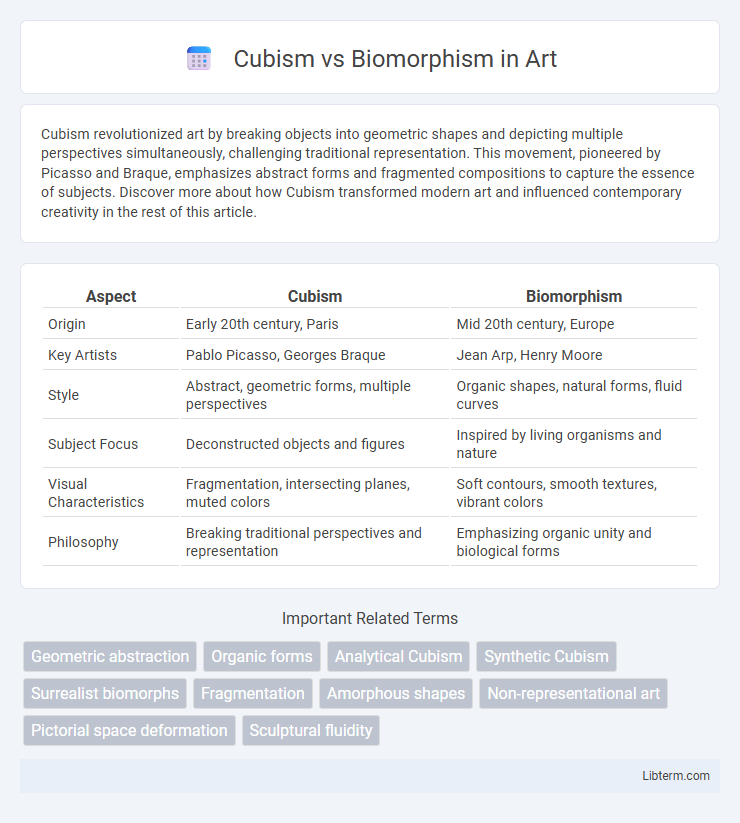Cubism revolutionized art by breaking objects into geometric shapes and depicting multiple perspectives simultaneously, challenging traditional representation. This movement, pioneered by Picasso and Braque, emphasizes abstract forms and fragmented compositions to capture the essence of subjects. Discover more about how Cubism transformed modern art and influenced contemporary creativity in the rest of this article.
Table of Comparison
| Aspect | Cubism | Biomorphism |
|---|---|---|
| Origin | Early 20th century, Paris | Mid 20th century, Europe |
| Key Artists | Pablo Picasso, Georges Braque | Jean Arp, Henry Moore |
| Style | Abstract, geometric forms, multiple perspectives | Organic shapes, natural forms, fluid curves |
| Subject Focus | Deconstructed objects and figures | Inspired by living organisms and nature |
| Visual Characteristics | Fragmentation, intersecting planes, muted colors | Soft contours, smooth textures, vibrant colors |
| Philosophy | Breaking traditional perspectives and representation | Emphasizing organic unity and biological forms |
Introduction to Cubism and Biomorphism
Cubism, pioneered by Pablo Picasso and Georges Braque in the early 20th century, revolutionized visual art by breaking objects into geometric shapes and representing multiple viewpoints simultaneously, emphasizing abstract form over realistic depiction. Biomorphism, emerging in the 1920s and 1930s, draws inspiration from organic, natural forms, incorporating fluid, life-like shapes that evoke biological structures in sculpture and painting. Both movements challenge traditional representation, with Cubism focusing on fragmented geometry and Biomorphism emphasizing curvilinear shapes inspired by nature.
Historical Origins and Development
Cubism, originating in the early 20th century with pioneers Pablo Picasso and Georges Braque, emphasized fragmented forms and multiple viewpoints to depict objects in abstracted geometric shapes. Biomorphism emerged in the 1920s as an organic art movement inspired by natural forms and living organisms, characterized by flowing, curvilinear shapes exemplified in the works of Jean Arp and Henry Moore. While Cubism revolutionized visual perception through analytical deconstruction, Biomorphism sought to integrate art with natural life by evoking growth and fluidity in design and sculpture.
Key Artists and Movements
Cubism, pioneered by Pablo Picasso and Georges Braque in the early 20th century, revolutionized art with fragmented, geometric forms emphasizing multiple perspectives. Biomorphism emerged in the 1930s, championed by artists like Jean Arp and Henry Moore, featuring organic, flowing shapes inspired by natural forms and living organisms. Both movements significantly influenced modern art, with Cubism driving abstract representation and Biomorphism focusing on surreal, nature-inspired aesthetics.
Philosophical Foundations
Cubism is grounded in the philosophical foundation of breaking down objects into geometric shapes to represent multiple perspectives simultaneously, reflecting a rational and analytical approach to reality. Biomorphism embraces organic, fluid forms inspired by natural shapes and living organisms, emphasizing an intuitive and holistic connection to the subconscious and life processes. These differing philosophies highlight Cubism's focus on abstract structure versus Biomorphism's celebration of natural growth and transformation.
Visual Characteristics and Aesthetics
Cubism features fragmented forms, geometric shapes, and multiple perspectives that challenge traditional representation, emphasizing abstract structure and spatial complexity. Biomorphism embraces organic, fluid shapes inspired by natural forms, characterized by smooth curves, asymmetry, and a sense of growth or movement. The aesthetics of Cubism prioritize intellectual engagement through deconstruction, while Biomorphism evokes emotional response by mimicking living organisms' dynamic and harmonious qualities.
Techniques and Mediums Used
Cubism employs fragmented geometric shapes and multiple perspectives, primarily using oil paints on canvas to deconstruct subjects into abstracted forms. Biomorphism favors organic, fluid shapes inspired by natural life forms, often realized through sculpture, ceramics, and mixed media to evoke living organisms' essence. Both movements utilize innovative techniques but diverge in their visual language, with Cubism emphasizing structural analysis and Biomorphism embracing naturalistic abstraction.
Representation of Form and Space
Cubism deconstructs objects into geometric shapes and multiple perspectives, emphasizing fragmented and abstracted representation of form and space. Biomorphism, inspired by natural organisms, employs organic, flowing shapes to create a sense of life and movement within the form, often maintaining a more fluid spatial relationship. These contrasting approaches highlight Cubism's analytical space versus Biomorphism's dynamic, naturalistic spatial interpretation.
Influence on Modern and Contemporary Art
Cubism revolutionized modern art by deconstructing objects into geometric shapes, influencing movements such as Futurism and Abstract Expressionism with its analytical approach to form and perspective. Biomorphism introduced organic and natural shapes, inspiring surrealists and contemporary artists to explore fluidity and the subconscious through abstract, living forms. Both styles significantly shaped modern and contemporary art by challenging traditional representation and expanding artistic expression toward abstraction and innovation.
Critical Reception and Legacy
Cubism garnered critical acclaim for its revolutionary approach to fragmented forms and multi-perspective representation, significantly influencing modern art movements like Futurism and Constructivism. Biomorphism, praised for its organic shapes and fluidity, challenged rigid geometric abstraction by emphasizing natural forms and subconscious creativity, impacting Surrealism and Abstract Expressionism. Both styles have left enduring legacies in contemporary art, with Cubism's analytical dismantling of perspective and Biomorphism's emotive, life-inspired shapes continuing to inspire artists and designers worldwide.
Cubism vs Biomorphism: A Comparative Analysis
Cubism revolutionized visual art by deconstructing objects into geometric shapes and multiple perspectives, emphasizing abstract form and spatial relationships. Biomorphism, contrastingly, draws inspiration from natural forms and organic shapes, integrating fluid lines and curves to evoke living organisms and natural growth. The comparative analysis reveals Cubism's focus on analytical fragmentation and intellectual reconstruction, whereas Biomorphism prioritizes intuitive, organic expression reflecting nature's vitality.
Cubism Infographic

 libterm.com
libterm.com